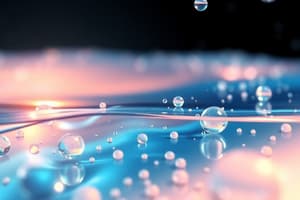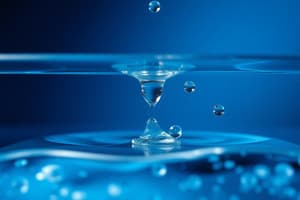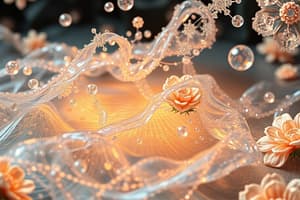Podcast
Questions and Answers
What effect do soaps and detergents have on surface tension?
What effect do soaps and detergents have on surface tension?
- They lower surface tension. (correct)
- They increase surface tension.
- They only affect surface tension at high temperatures.
- They have no effect on surface tension.
Which substance listed has the highest surface tension at 25°C?
Which substance listed has the highest surface tension at 25°C?
- Ethanol
- Glycerol
- Water
- Mercury (correct)
How does the presence of impurities affect surface tension?
How does the presence of impurities affect surface tension?
- It decreases surface tension. (correct)
- It increases surface tension.
- It only affects surface tension in liquids with high viscosity.
- It has no effect on surface tension.
What characteristic do hydrophobic substances display in a liquid?
What characteristic do hydrophobic substances display in a liquid?
At 25°C, which substance has a surface tension closest to that of octanol?
At 25°C, which substance has a surface tension closest to that of octanol?
What is the primary reason surface molecules experience a net inward pull?
What is the primary reason surface molecules experience a net inward pull?
What does surface tension define regarding force on a surface?
What does surface tension define regarding force on a surface?
What is the typical lifetime of a molecule at the surface before it enters the bulk?
What is the typical lifetime of a molecule at the surface before it enters the bulk?
What happens to the surface tension of water as temperature increases?
What happens to the surface tension of water as temperature increases?
Which of the following statements is true about surface free energy?
Which of the following statements is true about surface free energy?
At what temperature is the surface tension of water approximately 72 mN m-1?
At what temperature is the surface tension of water approximately 72 mN m-1?
What effect does higher temperature have on water's cleaning capability?
What effect does higher temperature have on water's cleaning capability?
What is the relationship between surface tension and surface free energy?
What is the relationship between surface tension and surface free energy?
What is defined as the transition region where two immiscible phases contact each other?
What is defined as the transition region where two immiscible phases contact each other?
What type of interface exists between two liquids?
What type of interface exists between two liquids?
What occurs to reduce the energy at the surface of a liquid?
What occurs to reduce the energy at the surface of a liquid?
How can the surface free energy of a solid be increased?
How can the surface free energy of a solid be increased?
What is a consequence of having higher surface area in solids?
What is a consequence of having higher surface area in solids?
What happens to surface molecules compared to those in the bulk?
What happens to surface molecules compared to those in the bulk?
Which of the following describes the energy needed to increase the surface area of a solid or liquid?
Which of the following describes the energy needed to increase the surface area of a solid or liquid?
Surface tension occurs in which type of interface?
Surface tension occurs in which type of interface?
What does the du Nouy tensiometer primarily measure?
What does the du Nouy tensiometer primarily measure?
What is the formula for calculating the detachment force using the du Nouy tensiometer?
What is the formula for calculating the detachment force using the du Nouy tensiometer?
What structural characteristic makes surfactants amphipathic?
What structural characteristic makes surfactants amphipathic?
What is the significance of Traube’s rule in the context of surfactants?
What is the significance of Traube’s rule in the context of surfactants?
In the structure of surfactants, what does the hydrophobic group typically consist of?
In the structure of surfactants, what does the hydrophobic group typically consist of?
What must be true regarding the contact angle when using the du Nouy tensiometer for accurate measurements?
What must be true regarding the contact angle when using the du Nouy tensiometer for accurate measurements?
What happens to surfactants in solution in relation to their structural components?
What happens to surfactants in solution in relation to their structural components?
What effect does a longer hydrocarbon chain have on surfactant behavior?
What effect does a longer hydrocarbon chain have on surfactant behavior?
What happens to surface tension when surfactants replace water molecules?
What happens to surface tension when surfactants replace water molecules?
Which of the following is a characteristic of emulsions?
Which of the following is a characteristic of emulsions?
How does the addition of surfactants affect the stability of an oil-in-water emulsion?
How does the addition of surfactants affect the stability of an oil-in-water emulsion?
What contributes to the spontaneous separation of oil and water in a liquid paraffin-water emulsion?
What contributes to the spontaneous separation of oil and water in a liquid paraffin-water emulsion?
What is the result of shaking an oil-in-water emulsion?
What is the result of shaking an oil-in-water emulsion?
Which statement about surfactants is correct?
Which statement about surfactants is correct?
What is the effect of adding sodium dodecyl sulphate to a water-in-oil emulsion?
What is the effect of adding sodium dodecyl sulphate to a water-in-oil emulsion?
Why is the water-water attractive force significant in emulsion stability?
Why is the water-water attractive force significant in emulsion stability?
What is the relationship between contact angle (θ) and wetting of a surface?
What is the relationship between contact angle (θ) and wetting of a surface?
What is the purpose of using a Wilhelmy Plate in surface tension measurement?
What is the purpose of using a Wilhelmy Plate in surface tension measurement?
In calculating surface tension using the Wilhelmy Plate method, what must be ensured?
In calculating surface tension using the Wilhelmy Plate method, what must be ensured?
What does the equation γl/v = F/P represent in the context of the Wilhelmy Plate?
What does the equation γl/v = F/P represent in the context of the Wilhelmy Plate?
How is the perimeter (P) of the Wilhelmy Plate relevant in calculations?
How is the perimeter (P) of the Wilhelmy Plate relevant in calculations?
In the calculation example provided, what is the surface tension of liquid A at 200C?
In the calculation example provided, what is the surface tension of liquid A at 200C?
What is a condition for the Wilhelmy Plate to function accurately in static mode?
What is a condition for the Wilhelmy Plate to function accurately in static mode?
Why is the Wilhelmy Plate method referred to as an absolute method?
Why is the Wilhelmy Plate method referred to as an absolute method?
Flashcards
Interface
Interface
The boundary region where two immiscible phases come into contact.
Surface Tension
Surface Tension
The attractive force between molecules at the surface of a liquid, causing the liquid to minimize its surface area.
Interfacial Tension
Interfacial Tension
The attractive force between molecules at the boundary of two immiscible liquids, causing them to minimize their interfacial area.
Surface Free Energy
Surface Free Energy
Signup and view all the flashcards
Minimizing Surface Area
Minimizing Surface Area
Signup and view all the flashcards
Increasing Surface Area
Increasing Surface Area
Signup and view all the flashcards
Milling of Solids
Milling of Solids
Signup and view all the flashcards
Handling Fine Particles
Handling Fine Particles
Signup and view all the flashcards
Surfactants
Surfactants
Signup and view all the flashcards
Hydrophobic
Hydrophobic
Signup and view all the flashcards
Hydrophilic
Hydrophilic
Signup and view all the flashcards
Wetting
Wetting
Signup and view all the flashcards
Liquid/Vapor Surface Tension
Liquid/Vapor Surface Tension
Signup and view all the flashcards
Interfacial Free Energy (Oil/Water)
Interfacial Free Energy (Oil/Water)
Signup and view all the flashcards
Surface Tension of Water
Surface Tension of Water
Signup and view all the flashcards
Surface Tension and Temperature
Surface Tension and Temperature
Signup and view all the flashcards
Dynamic Equilibrium at the Surface
Dynamic Equilibrium at the Surface
Signup and view all the flashcards
Lifetime of a Surface Molecule
Lifetime of a Surface Molecule
Signup and view all the flashcards
du Nouy tensiometer
du Nouy tensiometer
Signup and view all the flashcards
du Nouy tensiometer equation
du Nouy tensiometer equation
Signup and view all the flashcards
Hydrophobic group
Hydrophobic group
Signup and view all the flashcards
Hydrophilic group
Hydrophilic group
Signup and view all the flashcards
Traube's rule
Traube's rule
Signup and view all the flashcards
Surfactant orientation
Surfactant orientation
Signup and view all the flashcards
Amphipathic
Amphipathic
Signup and view all the flashcards
Surface tension: Energy
Surface tension: Energy
Signup and view all the flashcards
Emulsion
Emulsion
Signup and view all the flashcards
Water-soluble surfactant
Water-soluble surfactant
Signup and view all the flashcards
Oil-soluble surfactant
Oil-soluble surfactant
Signup and view all the flashcards
Contact Angle
Contact Angle
Signup and view all the flashcards
Absolute Wetting
Absolute Wetting
Signup and view all the flashcards
No Wetting
No Wetting
Signup and view all the flashcards
Wilhelmy Plate Method
Wilhelmy Plate Method
Signup and view all the flashcards
Force in Wilhelmy Plate Method
Force in Wilhelmy Plate Method
Signup and view all the flashcards
Absolute Wilhelmy Plate Method
Absolute Wilhelmy Plate Method
Signup and view all the flashcards
Static Mode of Wilhelmy Plate Method
Static Mode of Wilhelmy Plate Method
Signup and view all the flashcards
Surface Tension Calculation
Surface Tension Calculation
Signup and view all the flashcards
Study Notes
MPharm Programme: Surface Tension & Surfactants
- Surface tension is a property of liquids at their interface with a gas, where the liquid-gas interface acts like a skin. A similar concept, interfacial tension, applies where both phases are liquids.
- Surface tension arises from cohesive forces between liquid molecules, pulling them inwards. Surface molecules experience a net downward pull, which leads to a tendency for the surface to contract.
- Surface molecules have more energy than molecules in the bulk of the liquid, due to their differing interactions with neighbouring molecules.
- The energy needed to increase liquid surface area is called surface free energy.
- Water droplets assume a spherical shape due to the minimizing of surface area.
- Larger surface areas in solids (e.g., fine powders) create more free energy, making them more reactive.
- Increasing surface area in solids or liquids demands energy input.
- Surface tension is the force acting parallel to the surface, perpendicular to a one-meter line on the surface. It's numerically equivalent to surface free energy.
- Surface tension of water (25°C) is 72 mN m⁻¹ and declines with increasing temperatures. This impacts pore/fissure penetration in cleaning agents (hot water is more effective than cold).
- Surfactants are amphipathic molecules, combining hydrophobic (water-repelling) and hydrophilic (water-attracting) regions.
- Surfactants lower surface/interfacial tension by adsorbing at interfaces. Hydrophobic tails protrude away from the aqueous phase, while hydrophilic heads engage with the aqueous phase.
- The longer the surfactant chain, the more energetically favorable adsorption at interfaces and the greater the tendency for the molecule to leave the aqueous phase.
- Traube's rule describes how the ratio of surfactant concentration at the surface, to the bulk concentration, increases with the number of methylene groups in the alkyl chain. This occurs due to the increase in the tendency to escape from the aqueous phase.
- Emulsions (colloidal mixtures of two immiscible liquids) are stabilized by surfactants, forming a boundary film between the phases.
- Surfactants are used in various pharmaceutical preparations (e.g., emulsifying agents, detergents, solubilizing agents, wetting agents, foaming & antifoaming agents, flocculating agents).
- Several methods exist for measuring surface tension (e.g., Wilhelmy plate method, du Nouy tensiometer).
Measurement Methods
- Wilhelmy Plate: A thin plate dipped into the liquid; the force needed to remove it is measured to calculate surface tension. Zero contact angle is important for accurate readings. Can be used in static mode to track changes in surface tension over time.
- du Nouy Tensiometer: A platinum ring is dipped into the liquid and the force to detach it from the surface is measured to establish surface tension. Requires zero contact angle and a correction factor for accurate readings.
Calculation Examples
- Calculation of surface tension from a Wilhelmy plate force measurement involves dividing the measured detachment force by the perimeter of the plate. Ensuring all measurements are in consistent unit systems (e.g., meters).
Surfactant Action/Examples
- Liquid paraffin and water emulsions: Surfactants reduce interfacial tension between immiscible liquids, allowing them to be mixed and creating a stable emulsion.
Studying That Suits You
Use AI to generate personalized quizzes and flashcards to suit your learning preferences.
Related Documents
Description
Explore the intricate properties of surface tension and surfactants in liquids. This quiz delves into the physics of liquid interfaces, the concept of interfacial tension, and the energetic dynamics involved in surface area changes. Perfect for MPharm students looking to deepen their understanding of these essential topics.





